Post horn set
The post horn set , officially known as a series of digits , is a set of 16 postage stamps from the Deutsche Bundespost . The issue is classified in the category of postage stamps or permanent series . The definition for this is a relatively simply designed brand image that differs in the individual values only through color and value number. A striking feature of the series of digits is the state designation "Deutsche Bundespost", which was only introduced in 1950 with the only special stamp set of the year (consisting of 2 stamps) on the 200th anniversary of Johann Sebastian Bach's death . Postage stamp issues that were previously published in 1949 ( opening of the first German Bundestag , 100 years of German postage stamps , 75 years of the Universal Postal Union and Helpers of Mankind (I) as a welfare issue ) were labeled “Deutsche Post”.
history
Initial plans for the issue of a new series of postage stamps go back to 1949. Initially, it was intended to provide the stamps with the likeness of the then Federal President Theodor Heuss . However, the latter rejected a corresponding proposal from the Deutsche Bundespost . For this reason, the representatives of the Post responsible for the selection of motifs decided to take a step that was unusual according to the understanding of the time: they announced a competition endowed with cash prizes. A corresponding announcement was made on January 2, 1950 in the official gazette of the Federal Ministry for Post and Telecommunications .
The issue of the first values of 4 pfennig, 10 pfennig and 20 pfennig of the new permanent series took place on June 20, 1951. These show, like all other values in the series, a post horn in an oval field and a clearly highlighted number. This field is surrounded by a tape with the inscription "Deutsche Bundespost" in small capitals with weak serifs. The design came from Prof. Georg Alexander Mathéy ; the other award-winning designs that emerged from the design competition were not used.
The sale of stamps from the Posthorn series was discontinued on June 30, 1954; Remaining stocks could be used until December 31, 1954.
Printing technology and perforation
The printing took place in the Bundesdruckerei , with the denominations of 2 pfennig, 4 pfennig, 5 pfennig, 6 pfennig, 8 pfennig, 10 pfennig, 15 pfennig, 20 pfennig and 25 pfennig in letterpress , the denominations of 30 pfennig, 40 pfennig, 50 Pfennig, 60 Pfennig, 70 Pfennig, 80 Pfennig and 90 Pfennig were produced in intaglio printing , these higher values are also somewhat larger than those values from 2 to 25 Pfennig. All stamps have serration .
List of expenses
| image | Value in Pf | Issue date | Mi. -No. |
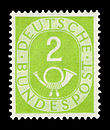
|
2 | Aug 1, 1951 | 123 |

|
4th | June 20, 1951 | 124 |

|
5 | Aug 1, 1951 | 125 |
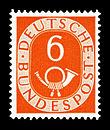
|
6th | Sep 20 1951 | 126 |

|
8th | Sep 20 1951 | 127 |

|
10 | June 20, 1951 | 128 |

|
15th | Sep 20 1951 | 129 |
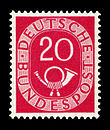
|
20th | June 20, 1951 | 130 |
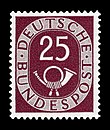
|
25th | Sep 20 1951 | 131 |

|
30th | Aug 1, 1951 | 132 |
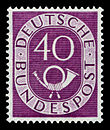
|
40 | Dec 20, 1951 | 133 |

|
50 | March 11, 1952 | 134 |

|
60 | Dec 20, 1951 | 135 |

|
70 | March 11, 1952 | 136 |
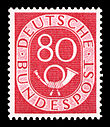
|
80 | Apr 16, 1952 | 137 |

|
90 | Apr 16, 1952 | 138 |
Early uses, i.e. use before the actual first issue date, can be proven with the values 6 pfennig, 8 pfennig, 15 pfennig and 25 pfennig from September 15, 1951. These brands were sold and used in Erlangen.
Prices
The post horn set is in the mint version with 2200 € the highest valued stamp set in the Federal Republic of Germany. The three highest values of the set with 70, 80 and 90 pfennigs are with values of currently 500, 500 and 550 € in perfect mint condition (i.e. perfectly centered, perfect perforation and absolutely untouched, unreasonable gum) among the most expensive postage stamps in Europe since the second World War to find. In the stamped version (round stamp with clearly legible date) the post horn set is valued at € 50. A post horn set consisting of 16 horizontal pairs (i.e. two stamps together next to each other) costs at least 4,000 euros, in corner pieces sometimes over 6,000 euros.
Forgeries, reprints and variants
The risk of acquiring an inferior overall set is very high with the post horn set. So-called rubber counterfeits and adulterations occur most frequently. In earlier times, the so-called “folding technique” was often used to store the stamps, in which a small sticky label was attached to the stamp to stick it into a scrapbook. Such a sentence is not considered mint in today's sense (i.e. as issued by the post office with untouched and undamaged rubber coating) and is therefore not regarded as full. "Folded" sets are relatively cheap (from 300 euros) in stores. Counterfeiters very quickly came up with the idea of removing the fold and repairing the damage to the rubber backing that had resulted - sometimes very professionally - with the appropriate tools. Another approach used by counterfeiters was to use household chemicals to remove the country postmarks (made of rubber, only produce a very weak stamp mark), which were used until the 1960s, and to apply rubber to the stamps with rubber solution (available as rubber pens in stationery shops).
Such an imitation rubber is easily recognizable even for the layperson (tooth test, in which the mark with the perforation is pulled over the finger. Re-rubberized marks create a scratchy feeling). Full forgeries of the post horn stamps are extremely rare, since the production of intaglio printing on appropriate watermark paper (zigzag lines) is expensive and too time-consuming. There are known private reprints of the series of digits in offset printing. These can be easily distinguished by the glossy brand surface and the additional imprint “Facsimile 1986” on the front and back. The watermark variants that occur (falling and reversed zigzag lines) of the post horn set, in addition to the well-known plate defects and varieties (especially partially imperforated stamps), achieve top prices in collector's circles.
Stamp booklet
The first stamp booklet of the Deutsche Bundespost contained two booklet sheets with 19 stamps from the Posthorn series.
See also

literature
- Andreas Hahn: Simple and moving - the post horn series and the former postage stamp design of the Deutsche Bundespost . In: Das Archiv , Ed .: DGPT , 1/2009, p. 22 ff.
- Wolfgang Maaßen: The post horn series 1951/52 . Phil Creativ, Schwalmtal,
- 1st edition from 2001
- 2nd edition from 2013, ISBN 978-3-932198-41-0 , 184 pages
- Gerd H. Hövelmann: Posthorn letterpress stamps and the magnifying glass. (Continuation article ) In: Deutsche Briefmarken-Zeitung from issue No. 24/1997, p. 6 ff.
- Jan Billion: The post horn series - what you need to know about this issue . In: Deutsche Briefmarken-Revue (Issue 1, Issue 2, each middle section), 1991, PSBN Verlagsgesellschaft Düsseldorf
- Posthorn stamp booklet . In: Deutsche Briefmarken-Revue , 7/2003, p. 52, PSBN Verlagsgesellschaft Düsseldorf
- Gerd H. Hövelmann: plate flaw . In: Deutsche Briefmarken-Revue , 3/2013, pp. 42–46, PSBN Verlagsgesellschaft Düsseldorf
- Michael Burzan: The little "Posthorn" values . In: Briefmarkenspiegel , Issue 9/2001, pp. 10–11, Philapress Göttingen


